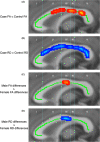Development of the corpus callosum and cognition after neonatal encephalopathy
- PMID: 36480557
- PMCID: PMC9852393
- DOI: 10.1002/acn3.51696
Development of the corpus callosum and cognition after neonatal encephalopathy
Abstract
Objective: Neonatal imaging studies report corpus callosum abnormalities after neonatal hypoxic-ischaemic encephalopathy (HIE), but corpus callosum development and relation to cognition in childhood are unknown. Using magnetic resonance imaging (MRI), we examined the relationship between corpus callosum size, microstructure and cognitive and motor outcomes at early school-age children cooled for HIE (cases) without cerebral palsy compared to healthy, matched controls. A secondary aim was to examine the impact of HIE-related neonatal brain injury on corpus callosum size, microstructure and growth.
Methods: Participants aged 6-8 years underwent MRI, the Movement Assessment Battery for Children Second Edition and Wechsler Intelligence Scale for Children Fourth Edition. Cross-sectional area, volume, fractional anisotropy and radial diffusivity of the corpus callosum and five subdivisions were measured. Multivariable regression was used to assess associations between total motor score, full-scale IQ (FSIQ) and imaging metrics.
Results: Adjusting for age, sex and intracranial volume, cases (N = 40) compared to controls (N = 39) demonstrated reduced whole corpus callosum area (β = -26.9, 95% confidence interval [CI] = -53.17, -0.58), volume (β = -138.5, 95% CI = -267.54, -9.56), fractional anisotropy and increased radial diffusivity (P < 0.05) within segments II-V. In cases, segment V area (β = 0.18, 95% CI = 0.004, 0.35), volume (β = 0.04, 95% CI = 0.001, 0.079), whole corpus callosum fractional anisotropy (β = 13.8 95% CI = 0.6, 27.1) and radial diffusivity (β = -11.3, 95% CI = -22.22, -0.42) were associated with FSIQ. Growth of the corpus callosum was restricted in cases with a FSIQ ≤85, and volume was reduced in cases with mild neonatal multifocal injury compared to white matter injury alone.
Interpretation: Following neonatal HIE, morphological and microstructural changes in the corpus callosum are associated with reduced cognitive function at early school age.
© 2022 The Authors. Annals of Clinical and Translational Neurology published by Wiley Periodicals LLC on behalf of American Neurological Association.
Conflict of interest statement
None declared.
Figures





References
-
- Lee‐Kelland R, Jary S, Tonks J, Cowan FM, Thoresen M, Chakkarapani E. School‐age outcomes of children without cerebral palsy cooled for neonatal hypoxic‐ischaemic encephalopathy in 2008‐2010. Arch Dis Child Fetal Neonatal Ed. 2020;105:8‐13. - PubMed
Publication types
MeSH terms
Grants and funding
LinkOut - more resources
Full Text Sources

